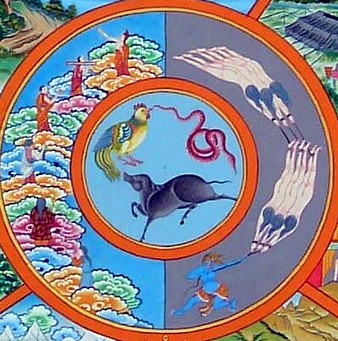Destructive emotions: Difference between revisions
mNo edit summary |
No edit summary |
||
| Line 1: | Line 1: | ||
[[Image:Kleshas.jpg|frame|The centre of the 'wheel of life': a pig representing ignorance, a cock representing desire and a snake representing anger]] | |||
'''Disturbing emotions''' (Skt. ''klesha''; Tib. ''nyönmong''; ''nyon mongs'') - the negative destructive emotions which are the cause of [[suffering]]. | '''Disturbing emotions''' (Skt. ''klesha''; Tib. ''nyönmong''; ''nyon mongs'') - the negative destructive emotions which are the cause of [[suffering]]. | ||
Revision as of 14:12, 22 May 2007

Disturbing emotions (Skt. klesha; Tib. nyönmong; nyon mongs) - the negative destructive emotions which are the cause of suffering.
Divisions
- The three main disturbing emotions are ignorance, attachment and aversion.
- When classified as five, pride and jealousy are added. Pride is a combination of ignorance and attachment, and jealousy is a combination of attachment and aggression.
- Six root disturbing emotions
- Twenty subsidiary disturbing emotions
Working with the Emotions
Ringu Tulku Rinpoche says:
- "Ignorance is the most fundamental of the kleshas, but also the most difficult to work with, so we need to begin with our attachment and aversion.
- Traditionally the teachings begin with attachment, but I think it is easiest to begin with anger or aversion. Attachment is so strong in us we are not really ready to work on it. Of course, if we can deal with attachment then aversion is taken care of automatically, whereas dealing with aversion will not necessarily rid us of attachment. But most people are not prepared to work on their attachment straight away, although they can quite easily see how anger and aversion are destructive and unpleasant.
- In a sutra it says this very clearly. It says that of the three poisons, ignorance is the most basic and pervasive. It is like the earth. If we can rid ourselves of this, we will rid ourselves of all the negative emotions, but this is difficult precisely because it is so deep and fundamental.
- Yet ignorance does not cause us acute pain or present immediate difficulties, nor will it throw us into the hells. So we can deal with it more slowly.
- Then attachment, it says, is like water: it is very pervasive. It causes us pain and suffering and it is not easy to get rid of. Attachment is not all bad—it has both a negative and positive side, e.g. compassion and love, or the resolution to become enlightened. We can be a little patient with this too. Water takes a long time to dry up.
- Aversion is compared to fire. It has almost no positive side. Wishing harm for others will always bring us suffering for others and for ourselves too. Aversion then is where we must begin. It has the quality of a flame: it bursts up very quickly and can burn away everything, but when the fuel is no longer there it will go down again just as quickly."
Translation
Alternative Translations
- Negative emotions
- Disturbing emotions
- (Mental) Afflictions (B. Alan Wallace)
- Defiled emotions
- Afflictive emotions
- Kleshas
- Dissonant emotions (Gyurme Dorje and Thupten Jinpa)
- Passions (Sangye Khandro following Dungse Thinley Norbu)
Definition
mi dge ba'i las bskul bas rang rgyud rab tu ma zhi bar byed pa'i sems byung
“mental events that incite one to unvirtuous actions and cause one’s being to be very unpeaceful” quoted in Creation and Completion, p. 102 n. 8
From the Great Dictionary:
lus sems gdung ba'i dka' las sam ngal dub dang, mi dge ba'i las bskul bas rang rgyud rab tu ma zhi bar byed pa'i sems byung,
“a mental state that afflicts the body and mind with difficulty and fatigue and makes one’s being extremely ill at ease by inciting one to unwholesome actions.”
Comments
Some translators prefer not to translate nyon mongs as emotion, because, as they point out, we would not immediately think of delusion and doubt, for example, as being ‘emotions’.